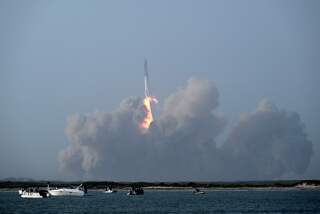Croissants Fly in Trump, Pan Am War
IBM executive Joel Saltzman was surprised to find warm croissants and free coffee at the Trump Shuttle’s terminal at Washington National Airport one recent morning.
He was even more surprised when a flight attendant cheerfully brushed croissant crumbs from his lapel as he boarded the plane. “You can’t go on looking like that,” she said.
The flight was on time--”it took off at 10:02,” Saltzman said--and service on his flight to New York was better than he had expected.
New York real estate magnate Donald J. Trump bought Eastern Airline’s Northeast air shuttle in June for $365 million, promising to turn the famed no-frills, hourly service into “a diamond.” But three months later, the Trump Shuttle is yet to be a gem.
It still looks a lot like Eastern. Most of its 727s are still blue and white, the colors of Eastern. On each fuselage, the Eastern name is covered over with a gigantic red “Trump” decal. The terminal decor is Eastern blue and white, and Trump flight attendants still wear their navy blue Eastern uniforms.
But by lavishing free food, coffee, magazines and newspapers on its customers, the upstart Trump Shuttle has brought a new intensity to one of the nation’s busiest and most lucrative airline markets. In the battle for customer loyalty, Trump is matching each move by shuttle rival Pan Am, doughnut for doughnut.
The competition is especially keen because Bruce R. Nobles, president of the Trump Shuttle, used to head the Pan Am shuttle. It was Nobles who came up with the idea to give Pan Am passengers free food and newspapers to scrape market share from then-powerful Eastern.
Pan Am built slowly, picking up about 35% of the market. But then, last March 4, a machinists’ strike--quickly joined by pilots and flight attendants--crippled Eastern and its shuttle. That led to the shuttle’s sale to Trump--but not before Pan Am had snapped up two-thirds of the market.
Nobles knows the Pan Am shuttle inside out--and the president of the Pan Am shuttle, Harris K. Herman, knows Nobles just as well. Herman, a lanky man with a mop of gray hair, had been Nobles’ top lieutenant since Pan Am began its shuttle operation in October, 1986.
Their relationship remains friendly: Herman recently telephoned Nobles to twit him about hiring away the Pan Am shuttle’s chief accountant. And Nobles keeps in his office a mock memo from Pan Am Corp. Chairman Thomas Plaskett to Herman concerning Nobles’ move to Trump. It says: “We’re in big trouble now.”
“I like it,” Nobles said, “because it reminds me of Pan Am, and where I am now.”
The stakes are high, because a successful shuttle is a money machine. While the rest of Pan Am loses gobs of money, its shuttle operation is solidly profitable. Nobles confidently predicts profits of $18 million for Trump by the end of its first 12 months.
Operating Costs
It is not hard to see why the shuttles--which fly between New York and Washington and New York and Boston--are so lucrative. A one-way ticket from New York to Washington, a distance of 205 miles, costs $99 or about 48 cents a mile. A one-way ticket from New York to Los Angeles, a distance of 2,450 miles, on the other hand, costs $588 or 24 cents a mile.
The shuttle executives argue that the high price is justified because a shuttle is more expensive to operate than scheduled airline service between Los Angeles and San Francisco and other commuter markets. That is because the Trump and Pan Am shuttles guarantee every passenger a seat, meaning that an extra plane must always be kept in reserve.
If a plane is full, the shuttles roll out the second plane for the “extra passengers.” Over the Thanksgiving weekend, when the 165-seat 727s swell with college students, it is not unusual to fly three jets back-to-back from Boston to New York. And when the crowds get especially thick, as during the Eastern strike, the Pan Am shuttle borrows a couple of 254-seat Airbus A-300s from its parent, Pan American World Airways.
Unwilling to erode profits with lower fares, the Pan Am and Trump shuttles rush to shower bigger and better freebies on their customers. Both shuttles hand out cups of coffee, newspapers and such magazines as Modern Maturity and Four Wheeler by the thousands.
The terminal waiting areas have soft chairs with tables nearby, television sets and plenty of leafy plants to give them what Pan Am’s Herman calls a “living-room look.”
Strategy in the war over amenities is shrouded in secrecy. When workmen carved a small room from Pan Am’s waiting area earlier this year, Herman encouraged rumors that the airline was building a cocktail lounge.
The room, now completed, is actually a business lounge with two Wang personal computers, a facsimile machine, a photocopier, video equipment, telephones and a conference room. Pan Am calls it the “Business Club” and says 300 travelers use it each week.
On board the aircraft, Pan Am and Trump try hard to outdo each other. Pan Am pampers its passengers with soft, leather seats--very different from the cloth seats on Pan Am’s Europe-bound jumbo jets. And there are 54 telephones on each Pan Am shuttle 727, two in every row.
Sense of Style
The number of phones may seem excessive, since only four can be used at any one time. But it looks good to have so many, Herman said. And besides, he said, “no one has to get out of their seat to make a call.”
Trump’s seats, still covered with Eastern’s blue cloth, are far from luxurious, but the airline’s billionaire owner has big plans. Not only will Trump planes have leather seats and 54 telephones to match Pan Am, but the restrooms will have pink marble-look vanities, make-up lights and burgundy-colored porcelain sinks. “We’re trying to provide a sense of style and class,” Nobles said.
As for the outside of Trump’s planes, by mid-October his 21 jets will be repainted in bold black, red, and gold stripes with the Trump name stamped on each tail. The design is fashioned after the glittering piping on Trump’s private jet, and will cost thousands of dollars more than a standard paint job. “We couldn’t talk him out of it,” Nobles said.
When it comes to menus, the two airlines tussle with the passion of McDonald’s and Burger King. Pan Am secretly sends employees on undercover trips on the Trump Shuttle to check out the service and the food.
One of the first changes that Trump made was to beef up the snacks, since all that Eastern offered were popcorn and soft drinks. Now Trump offers about a dozen different snack packs, scheduling them carefully over several days so that passengers are not likely to get the same snack twice. A typical Trump snack includes two cookies, soft Cheddar cheese and crackers, peanuts and a bag of pretzels.
Pan Am is unimpressed. “We didn’t find anything we want to run out and match,” Pan Am’s Herman said. “We give our customers fruit--they like it better than dry snacks.” Herman said Pan Am’s search for a better snack led it to the state of Washington, where it discovered “tiny, almost bite-size apples” to substitute for out-of-season plums.
New York cab drivers share in the shuttles’ bounty. The loyalty of cab drivers is important to Pan Am and Trump, since two-thirds of shuttle passengers arrive and leave the airport by taxi. Trump gave 5,000 clipboards and caps as gifts to taxi drivers when the airline got started 12 weeks ago. Pan Am gave away clipboards and sandwiches when it went into the shuttle business, and it still occasionally gives early-rising cab drivers free breakfasts.
Market Share Battle
New York cabbie Raphael Lalanne said it is clear to him that Trump is gaining on Pan Am. “Before Trump came in, a lot of people went to Pan Am. Now, I take a lot of people to Trump.”
The two airlines do not agree on how the market is divided, but it is clear that Trump is gaining share. Trump’s Nobles contends that the upstart has won “47% of the market, and at least 45%”--up from around 35% three months ago. Pan Am claims 60% of the market.
Nobles said the new airline’s secret weapon is the “Trump factor,” what he describes as a mystique about the high-profile billionaire and his glamorous possessions--the airline, Atlantic City casinos, luxury New York hotels, and high-rent office towers. Nobles thinks that travelers will give the Trump Shuttle a try out of curiosity and will stay with the airline if they like what they see.
Interviews with travelers at New York’s LaGuardia Airport recently turned up some evidence of the Trump factor at work. Michael Benton, director of the Irving, Tex., convention bureau, flew Trump from Boston to New York to check out the new airline. “There was so much hype about it, I just had to try it.”
Not everyone finds Trump’s glitzy image endearing. University of California business Professor Charles A. Reilly III flew to New York from Washington on Pan Am because he dislikes Trump’s slick, magazine-cover style--”all that pomp and circumstance,” as he put it.
Trump’s hands-on management style came into play Aug. 10, when a disabled Trump 727 skidded to a stop at Boston’s Logan Airport. The plane’s front landing gear did not drop into position, so the 727 came in on two wheels. Sparks flew when the nose touched down.
No one was hurt, but Trump and Nobles flew immediately to Boston to praise the crew for a safe landing and to hold a brief news conference. A few weeks later, Trump sent letters of apology to the plane’s 49 passengers. “When your name is on the plane, you react differently,” Nobles said.
Though Pan Am’s business from Boston increased a bit immediately after the accident, a top strategist at Pan Am praised Trump’s response. By flying to Boston, he drew attention to himself and away from the accident. “He totally diffused that situation.”
Even so, some travelers say they are wary. Michael DeNofrio and Jylanne Dunne, investment managers for American Express in Boston, witnessed the accident and said they feel more comfortable with Pan Am.
Besides, Dunne said, she likes to take the Pan Am “water shuttle”--a ferry with seats on its open upper deck that carries passengers from the airport to Wall Street and back. The water shuttle makes just one stop at LaGuardia--at the Pan Am terminal.
More to Read
Inside the business of entertainment
The Wide Shot brings you news, analysis and insights on everything from streaming wars to production — and what it all means for the future.
You may occasionally receive promotional content from the Los Angeles Times.










